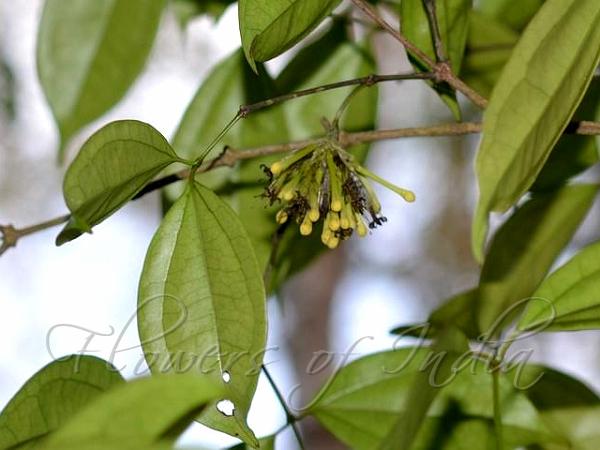|
| Poison-Fruit Vine |
|

|

|
|
|
|
Photo: |
Botanical name: Strychnos wallichiana Family: Loganiaceae (Logania family)
Synonyms: Strychnos cinnamomifolia, Strychnos lucida, Strychnos tubiflora
Synonyms: Strychnos cinnamomifolia, Strychnos lucida, Strychnos tubiflora
Poison-Fruit Vine is a woody climber up to 20 m long.
Stems are grayish white, rugose; branchlets round, smooth, usually with
2-divided tendrils in leaf-axils. Leaf-stalks are 5-7 mm; leaves
elliptic, 5-17 x 3-5 cm, basal veins 3. Flowers are borne inthyrses at
branch-ends, 4-5 cm, carried on velvet-hairy flower-cluster-stalks.
Flowers are yellowish to yellow-white, pinwheel-shaped. about 1.4 cm,
tube about 1.1 cm, petals oblong, about 4 mm, tip slightly thickened.
Stamens are inserted at flower mouth, pistil about 8 mm. Sepals are
ovate, 1-1.3 mm. Berries are yellow to orange when ripe, spherical, 4-6
cm in diameter, pericarp to 2-3 mm thick; many-seeded. Poison-Fruit
Vine is found in NE India, China, SE Asia and Western Ghats. Flowering:
April-June.
Medicinal uses: Although toxic, the plant is
taken internally as well as externally in traditional medicine.
However, internal use needs to be very carefully monitored by skilled
practitioners. The stem-bark and branch-bark are effective in treating
rheumatism, ostealgia, paralytic cramp of the extremities, lumbago,
sciatica, colic and diarrhoea. The bark is used internally as an
aphrodisiac; it is also said to be very efficacious in the treatment of
leprosy and is used as an antidote for rabies.
Although toxic, the plant is
taken internally as well as externally in traditional medicine.
However, internal use needs to be very carefully monitored by skilled
practitioners. The stem-bark and branch-bark are effective in treating
rheumatism, ostealgia, paralytic cramp of the extremities, lumbago,
sciatica, colic and diarrhoea. The bark is used internally as an
aphrodisiac; it is also said to be very efficacious in the treatment of
leprosy and is used as an antidote for rabies.
Medicinal uses:
 Although toxic, the plant is
taken internally as well as externally in traditional medicine.
However, internal use needs to be very carefully monitored by skilled
practitioners. The stem-bark and branch-bark are effective in treating
rheumatism, ostealgia, paralytic cramp of the extremities, lumbago,
sciatica, colic and diarrhoea. The bark is used internally as an
aphrodisiac; it is also said to be very efficacious in the treatment of
leprosy and is used as an antidote for rabies.
Although toxic, the plant is
taken internally as well as externally in traditional medicine.
However, internal use needs to be very carefully monitored by skilled
practitioners. The stem-bark and branch-bark are effective in treating
rheumatism, ostealgia, paralytic cramp of the extremities, lumbago,
sciatica, colic and diarrhoea. The bark is used internally as an
aphrodisiac; it is also said to be very efficacious in the treatment of
leprosy and is used as an antidote for rabies. | Identification credit: Vijayasankar Raman, I. Veera Kishore | Photographed in Aralam WLS, Kerala & Seshachalam, Andhra Pradesh. |
• Is this flower misidentified? If yes,